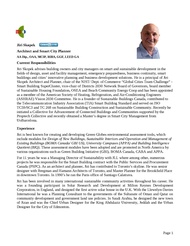Jiri Skopek
Jump to navigation
Jump to search
| Resume |

|

| ||
| Name | Jiri Skopek | |
| Company | Jiri Skopek Architects | |
| Company Position | Architect & Smart City Planner | |
| City, State | Toronto | |
| Country | Canada | |
| Sectors | Buildings Smart Region Transportation Utility Wellbeing Resilience Energy Waste Water Smart Buildings | |
| Consulting: green and smart buildings, sustainability, smart cities | ||
Activities

|
CIVIC school HUBS | |
| NSF CIVIC grant to incubate the Federal School Infrastructure Toolkit for more resilience Community services. A pilot program with be developed with the BENSON school district in Portland, and woven into the urban/rural network of the Metro regional emergency response. | ||

|
Community Engagement and Resilience Program | |
| This project aims to address the pressing challenges faced by economically disadvantaged and environmentally vulnerable communities in North Portland. These communities struggle with limited access to jobs, essential services, and face environmental hazards such as air pollution and lack of green spaces. The program seeks to empower local residents and businesses by providing workforce training in sustainable fields like vehicle electrification, energy efficiency, and urban design, while also fostering community-led engagement to improve resilience and promote equitable economic opportunities. | ||

|
Framework for Enhancing Disaster Mitigation and Regeneration of Community Capacity | |
| Establishment of a framework that fosters collaborative efforts between diverse public, private, and academic partners to enhance disaster mitigation, community resilience and economic growth. | ||

|
Green Horizons: Urban Workforce Development and Electrification Center | |
| The Green Horizons Workforce Development and Vehicle Electrification Center is pursuing a planning grant that aims to establish a positive sustainable economic impact for the Multnomah County Drainage District community. This project will produce an assessment plan for a combined workforce training and commercial grade EV fleet conversion facility. | ||

|
School Organized Locally Assisted Community Emergency‐Management | |
| The School Organized Locally Assisted Community Emergency‐Management (SOLACE) project focused on the use of a community school as a community resilience hub for its surrounding community. Community Resilience Hubs (CRHs) can be defined as community‐serving facilities augmented to support residents and coordinate resource distribution of resources and services to the surrounding community. This project focused specifically on the use of a CRM to support community member needs before, during, or after a natural hazard event and on developing a community‐led sociotechnical infrastructure framework for adapting a public school (Buckman Elementary School) as the pilot CRH. In 2022, this project received a NSF Planning Grant. | ||
Blueprint Chapters

|
City Resilience | |
| The previous chapter focused on technology development to support whole community planning for disaster recovery, with emphasis on the requirements for multi-agency planning and decision -making involving an entire community and its physical, economic, and social resources. Technology development strategies to enhance City (or Community) Resilience are closely aligned with capabilities for disaster recovery, insofar as they involve the entire scope of community functions. | ||

|
Floods | |
| The intensity of extreme rainfall has “sharply” increased over the past 20 years. While floods can be more regional in nature, satellite data show hydroclimatic extreme events are increasing in frequency, duration, and extent under warming conditions. Warmer temperatures increase evaporation, putting more moisture into the atmosphere that then gets released as rain or snowfall. It is also expected that, as the climate warms, flash floods will get “flashier,” meaning that the timing of the floods will get shorter while the magnitude gets higher. | ||

|
Grid-Interactive, Efficient and Connected Buildings (GEBs) | |
| This section explores why the buildings need to be efficient, responsive, and able to interact with the electrical grid in a way that benefits both the building owner and the grid as a whole and what KPIs can be used to measure the effectiveness of the grid-connected buildings. | ||

|
Interfacing Smart Buildings with City Services and Infrastructure | |
| This section discusses some of the opportunities relative to an interface of the buildings and city services and infrastructure where utility companies, local governments, and property owners can partner to improve the built environment, and operational efficiency, save money, and conserve resources.
The first part outlines the benefits of good Buildings and City infrastructure interface and describes the connections of Smart Buildings to City Services and Infrastructure. The second section will outline recommended KPIs of the good interface of building with urban services. The third section identifies various elements of Building-connected City Services and Infrastructure and the final section provides a Case Study. . | ||

|
Mobility | |
| Mobility has been a constantly evolving critical feature of human civilization. Major changes and advances in mobility have been linked to the advent of new power sources (animals, wind, steam, fossil fuels, super dense batteries, etc.). | ||

|
Next Generation Building Operations | |
| This section explores how the next generation of smart building operations, functionality and maintenance is utilizing the (IoT) internet of things to operate at full interconnectivity, functionality and efficiency. Smart building , operations, functionality and maintenance capabilities cut energy consumption and CO2 emissions, reduce maintenance costs and extend equipment lifetime. Various systems offer actionable insights, drive fewer complaints from occupants, decrease the need for unscheduled maintenance and reduce energy costs and carbon footprint. In the time of pandemic or other extreme events, smart buildings may offer autonomous operation. | ||

|
Organizational and Individual Productivity and Wellness of Smart Buildings | |
| This section explores the application of smart technologies in buildings to increase the ORGANIZATIONAL PRODUCTIVITY and WELLNESS of the various private/public sector stakeholders: the owners & investor organizations, property and facility management organizations, government and corporate tenants (i.e. organizations who occupy or rent space) and individual occupants. | ||

|
Public Safety-Resilience and Regeneration of Communities | |
| Extreme heat and heatwaves are becoming a significant concern for many world cities and communities, and it's rapidly worsening due to the impact of climate change. Extreme heat events have severe impacts on ecosystems, infrastructure, human health, and economies. These heatwaves are not only a consequence of escalating global temperatures, but they also symbolize an acute emergency for urban environments worldwide In several locations the extreme heat is exacerbated by poor air quality caused by smoke from wildfires. | ||

|
Resilience Hubs | |
| This chapter demonstrates how integrated smart systems that draw on a number of technologies, processes, and data can enable a community structures to function more efficiently for their main purpose as well as be prepared to serve as a “community resiliency hub” and/or “emergency shelter” as needed. Selecting a school as a community resilience hub leverages its existing function for families already charged with protecting children, employing vetted professionals, and communicating with parents, public safety agencies, and city government as well as embuing the school with some additional important functions and responsibilities to an extended community population. (The pilot for this project--using the Buckman School in Portland, Oregon--received a National Science Foundation Planning Grant in 2022.) | ||

|
Smart Building-related Mobility | |
| Buildings have a very symbiotic relationship with transportation. People have to get to the buildings on foot, by bicycle or other mobility devices, public transport or car (in exceptional cases by helicopter and in future by drone). Cars have created a demand for parking space in the building. Then there are deliveries and waste collection typically by trucks. | ||

|
Smart Buildings O&M | |
| This section explores how the next generation of smart building operations, functionality and maintenance is utilizing the Internet of Things (IoT) to operate at full interconnectivity, functionality and efficiency. | ||
Webinars

|
Supporting Community Cooperation in Urban Design | |
| Engagement, Visioning, Master Planning, and Making Agreements are found in a process that communities use to make meaningful change in their neighborhood. Community stories are precedents demonstrating the value of integrating nature with development to sustain active and vital community-oriented neighborhoods. | ||